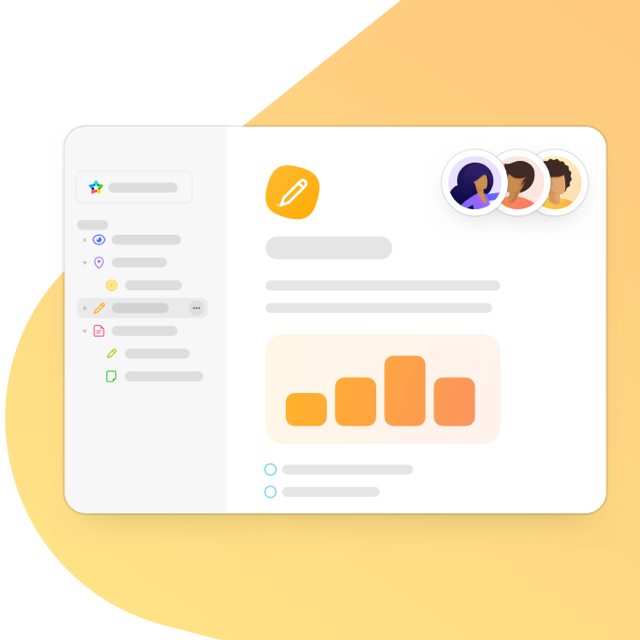Efficient, well-executed projects are the center of every dynamic company. However, as anyone who has worked in both successful and unsuccessful project teams will know, it is often the little things that make the difference. Project documentation, while not the most fashionable subject, is often a deciding factor. It is for this reason that our latest tool, MeisterNote, is specifically designed to help teams address the problems that project documentation can cause. Read on to find out more about the extensive applications of the tool and how you can create project documentation that works for you.
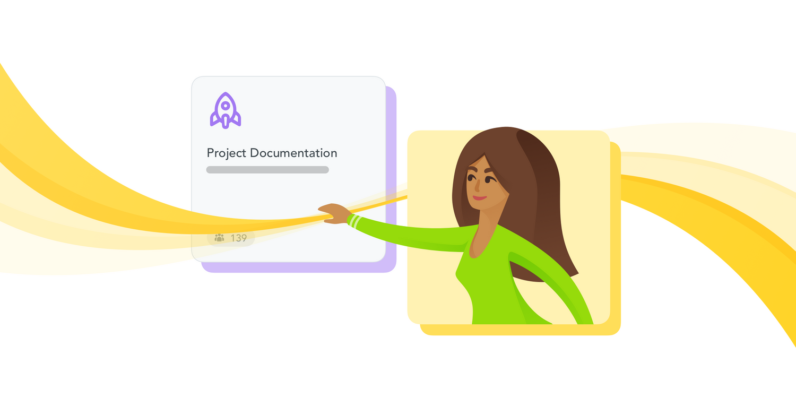
So, you’ve decided to start your next project. Then… it hits you. The dawning realization that eventually, you’ll have to write all of it down. Of course, the temptation is simply to defer dealing with documentation until a later date – do the work now, write it all down later. This could be a big mistake. As your project progresses, and your team searches for answers on important topics, a lack of written documentation could prove disastrous to alignment and productivity.
At Meister, we think that the importance of project documentation is underestimated: without it, projects can fall apart, but it remains one of the lesser-discussed elements in the project management community. Read on to learn why your project documentation may not be serving its purpose and how MeisterNote can bring clarity to the jungle of project paperwork.
What is Project Documentation?

However, project documentation is a means to an end. Its single goal is to facilitate project success, not to become a job in itself. Organizing project documentation into one, centralized area provides a single source of truth to the project team regarding the aims, status and results of the project in question. It brings otherwise scattered documents into one place, increasing alignment and ensuring goals are achieved.
Find out more about using MeisterNote for project documentation on our website.
Tools like MeisterNote are essential to this principle. As we planned and refined our newest tool, we took the inputs of project teams and project managers into account. The result – a tool that can centralize project documents, facilitate the creation of attractive project documentation, and remain simple and accessible to ensure smooth, distraction-free project work.
What Counts as Project Documentation?
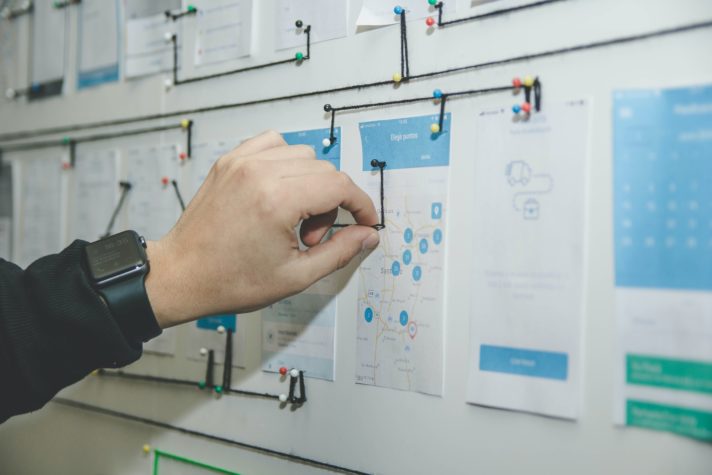
Although the exact extent of the project documentation you will need depends on the project itself, there are certain standard documents that provide much-needed structure to development, regardless of whether an agile or waterfall approach to project management is taken. Examples of project documentation include:
- Proposals
- Project plans and specifications
- Business cases
- Product requirement documents
- Design guidelines or sketches
- Roadmaps
- Project status reports
- Project team meeting minutes
Project documentation isn’t the sole responsibility of the project manager. Delegating responsibility for creating and maintaining documentation to other members of the project team may be more efficient.
Why Do Project Documentation Methods Fail?

Confusion regarding project work, caused by deficiencies in project documentation, may result from one or more of the following factors: bad planning, bad communication or bad organization. Some of the key reasons for failures in project documentation are:
- Alignment. Documentation can build up in many places: Slack, comments on tasks, support tickets, archived email threads, disconnected docs and plenty of other places. If there is no consistency in where information is published, it can be difficult to stay up-to-date when changes are made. Often, simply finding what you need can become a significant challenge.
- Communication issues. Project plans require collaboration beyond the meeting room. Comments enable this on tools such as Word and Google Docs, but when you resolve them, they are difficult to retrieve and contextualize.
- Storage problems. Even if you decide on one place to store your documents, folder structures can become confusing, leading to misuse or no use at all. Google Drive can become an unwelcoming black hole of project documentation, especially if multiple people are involved in its creation and organization.
- Lost materials. Information overloads and over-complicated documentation methods usually have one common result: information getting lost. If you can’t rely on your internal communication platforms to keep your team up-to-date, it is inevitable that knowledge loss will follow. Avoiding this is crucial to project success, and thus the overall ability of a company to get things done.
Benefits of an Effective Project Documentation Software
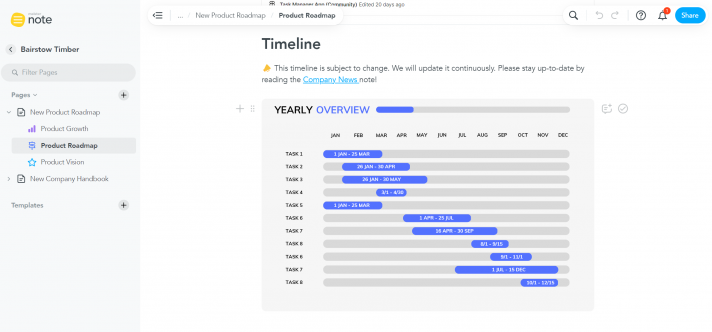
An effective project documentation tool should counteract the issues listed above while providing the scope to maximize collaboration and efficiency. The ability to manage project documentation effectively will allow each person involved in the project – from the project team to other stakeholders such as customers and corporate management – to operate with a clearer overview of project status. A good project documentation software should therefore allow teams to achieve the following outcomes:
- Record key project details to produce documents that help teams plan projects and implement those plans successfully.
- Centralize and organize all project documentation, from initial specs to planning to deliverables.
- Create documentation that helps team members fulfill their role in the project team.
- Create inspiring project plans and kickstart team participation within a flexible, attractive workspace.
We’ve summarized a few of these benefits, in addition to the MesiterNote features that will help you get the most out of your project documentation process, below.
See the full range of functionality in MeisterNote on our features page.
Clarity
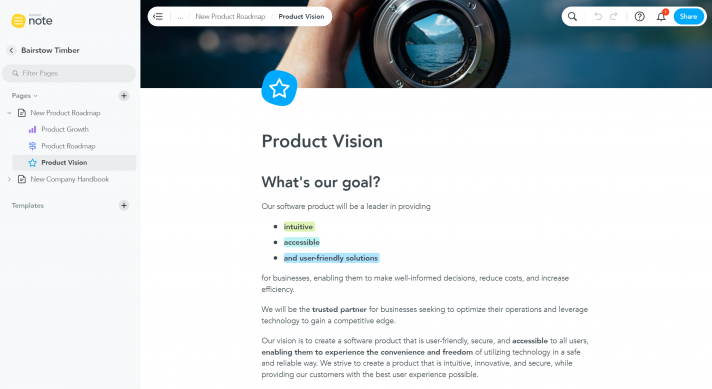
Project teams that aren’t working properly all ask the same question: “What are we meant to be doing?” Project Managers can use a project documentation tool like MeisterNote to tackle the confusion and to bring clarity and structure to their projects: from initiation to completion. Firstly, your project documentation needs to be easy to find, so selecting MeisterNote as your project’s single source of truth is a massive step in the right direction.
Key MeisterNote Feature: Notes and Pages
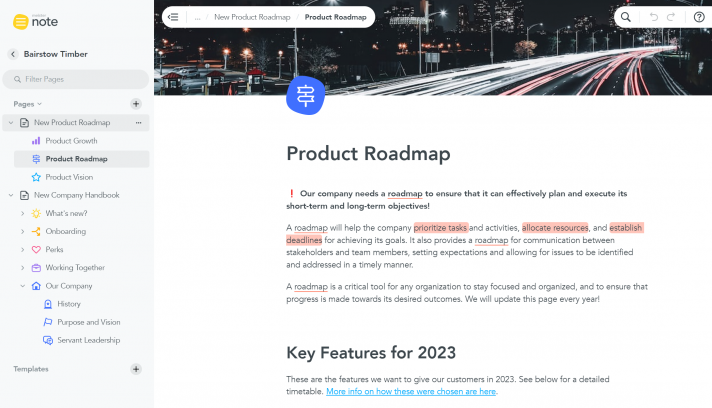
MeisterNote makes organization simple with its intuitive system of notes and pages, which allow you to structure your documentation logically (and thus find information again). In your notes, you can clarify project expectations and objectives, break down project work into manageable blocks and ensure that all stakeholders are informed about project progress.
Effective Knowledge Management
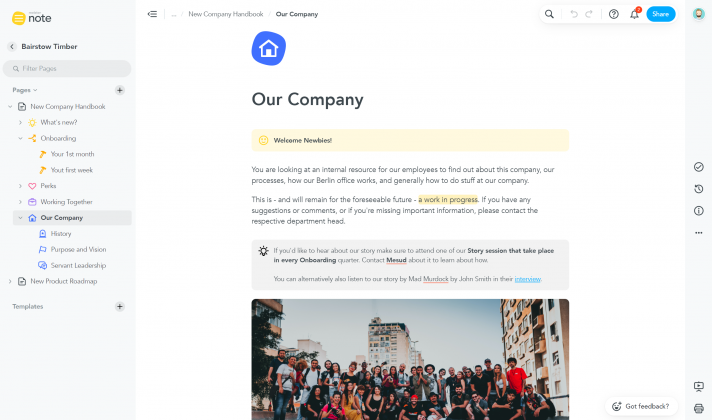
Project knowledge has two key purposes: ensuring that project work is completed effectively and ensuring that mistakes are learned from. This information is relevant not just within a single project, but across a company’s entire project portfolio. Using a project documentation tool, insights and lessons learned from one project can be transferred easily to new ones. This knowledge can help the team develop new best practices, prevent repeated mistakes, and continuously improve overall performance.
Key MeisterNote Feature: Duplication and Templates
MeisterNote makes it simple to recreate notes and pages that will be used in multiple places through templates and note duplication. This will save time in actually creating the content you need and ensure that future versions of project documentation are consistent with their predecessors. In paid MeisterNote plans, you can duplicate a notes and its pages at the same time, which could represent a significant time saving.
Find out how to create, move and duplicate your notes in our help center.
Better Team Alignment
Project documentation should bring clarity and transparency to what everyone is working on. This means that decisions and discussions must be kept centrally, transparently and accessible to the entire project team. Ensuring comprehensive written communication means less time is spent in meetings and work is less likely to get duplicated. Increased transparency makes sure the project team stays in the loop, while providing valuable context to other project stakeholders.
Key MeisterNote Feature: Comments and Mentions
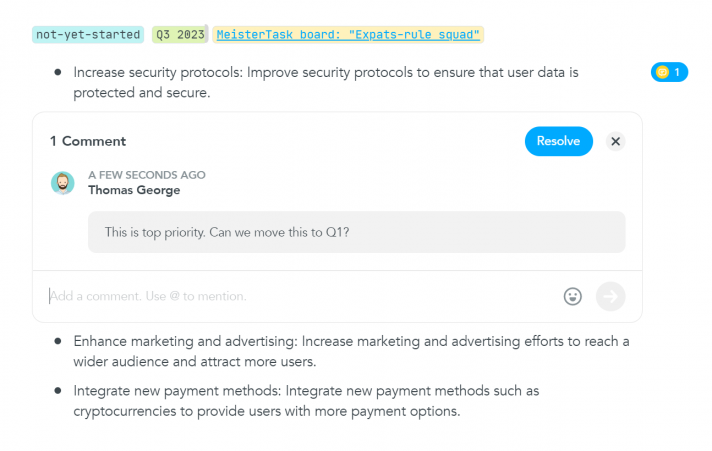
It’s good to talk. Yet Bill and Florence discussing a new update at the coffee machine does not help Sandra contribute to the project. On the other hand, recording the exchange of ideas directly in MeisterNote, does. MeisterNote’s comment and mentioning functionality is central to this: multiple discussion threads can run concurrently on one content block and be hidden quickly for an easy-to-read overview of the note. To grab a team member’s attention, simply @mention them: they’ll get a notification that brings them straight to the point.
Integration with Task Management Software
When creating project documentation, it’s best to keep any materials you create as close as possible to where the work actually happens. For the millions of MeisterTask users around the world who enjoy sleek, secure task management, MeisterNote makes fully-integrated project documentation incredibly simple. The MeisterNote integration with MeisterTask allows you to:
- Create new tasks in MeisterTask directly from MeisterNote.
- Link to existing MeisterTask tasks from note content blocks.
- Convert content blocks in MeisterNote into tasks in MeisterTask.
- Convert text segments in MeisterNote into tasks in MeisterTask.
- Perform task actions on linked tasks.
On a practical level, this means that you can easily create concrete tasks straight from your project plans without having to switch tools. Similarly, as you refer to your documentation at a later stage, you will also be able to monitor the progress of linked tasks without having to update manually. The benefits of the feature are self-evident: a full overview of project progress, all in one place.
How to Manage Project Documentation Throughout Your Project
Your project documentation requirements will differ depending on the stage your project is in. In this section, we’ll look through the different project phases in chronological order, providing useful tips to help you build and maintain documentation across the project lifecycle with MeisterNote.
Phase 1: Initiation

This is the first phase in a project’s life cycle. Initiation establishes your project team and outlines the key actions needed to bring your project to life. It also covers initial funding allocation and authorization, should these be relevant. At the end of the initiation phase, the project is formally approved and brought to life.
Documentation Required at this Stage
- Project proposal/business case. Explain what your project concept is and what problem it will ultimately address.
- Project scope statement. This is a list of objectives that the project should achieve (as well as what it should not achieve.)
- Team structure document. Briefly outline the project manager and project team.
- Project charter. Create this document after the project proposal is approved. It formalizes each of the above points in a unified document.
Use MeisterNote to set up a note structure and provide access to your entire project team at this point. Use the tool’s granular permission settings to help you do this. For your team structure document, you may find it helpful to create an org chart in MindMeister and embed it into your note.
Phase 2: Planning
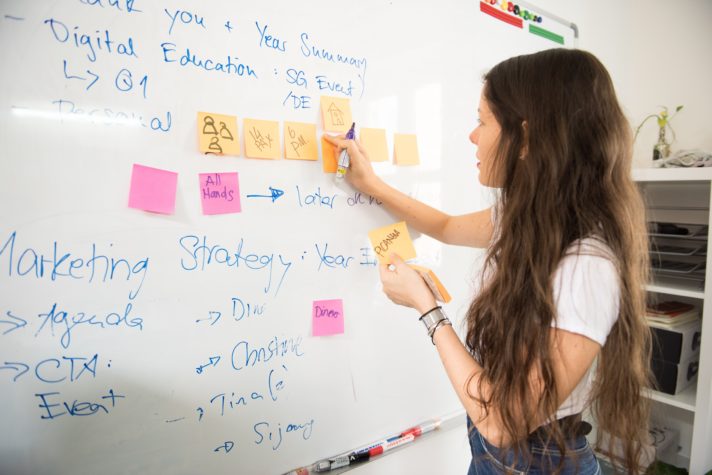
After project approval, the planning phase can begin. While different project requirements and actions are needed depending on the purpose of your project, planning is an absolutely critical stage that must be addressed logically and with great care.
Documentation Required at this Stage:
- Project Management Plan. This should contain details on: deliverables, time frame, budget, quality and version control, stakeholders and personnel and risk management.
- Project Roadmap. This outlines an initial schedule for deliverables, milestones and phases of your project. Be aware that the timeline will likely change throughout your project’s lifecycle.
- Financial Plan. This is the anticipated budget for your project. Your plan should cover topics like funding procurement and allocation, contracts, financial processes and even projected ROIS.
- Project Communication Plan. This establishes policies on meetings and updates within the project team. It details specific communication methods, communication frequency and contact information.
Your financial plan will probably be created in Microsoft Excel or similar. You can embed different document types into your notes in MeisterNote, which can be viewed without having to leave the tool. Find out more in our help center.
Phase 3: Execution

The execution or implementation phase of your project is when planning gets put into action. Your team will move from preparation mode to actually completing project work. This is often the longest phase of the project and the stage at which communication and alignment are most vital.
Documentation Required at this Stage:
- Risk & Issues Log or RAID logs (Risks, Assumptions, Issues & Dependencies). This is a log that helps keep track of project issues that come up predict future risks.
- Project Status Report. This is a regular report on project progress. It keeps everyone on the same page throughout the project lifecycle.
Your project status report is the perfect place to make the most out of the MeisterNote-MeisterTask integration. As task details will be outlined in MeisterTask itself, you can keep your plan easy-to-read without skipping on the details. Better still, information that is updated in MeisterTask will be automatically updated in your notes as well.
Phase 4: Control

The control phase focuses on observing the actions taken during the execution phase, identifying necessary changes and implementing these according to a defined change process. It can be seen as a “fine-tuning” of the work performed at the previous project phase.
Documentation Required at this Stage:
- Project Change Request Log. Whenever a change needs to be made to the original project plan, it should be requested and recorded in the change management section
You may have to include files and media from external sources to show project team members exactly which project change request items have been completed. It’s no problem in MeisterNote: with over 20 integrations to external content providers, keeping an overview is simple.
Phase 5: Conclusion

This stage is the official closure of the current project and a chance to look towards future projects. During this stage, you will conduct final meetings with the project team and stakeholders to reflect upon what went well during the project and what could be improved in future. The aim is to streamline processes and lay the groundwork for increased success in the future.
Documentation Required at this Stage:
- Project closure document. This is a project review document that formally concludes a project. It must be reviewed and approved by the project manager, sponsor and relevant stakeholders. The document should summarize what the project accomplished and/or produced, notable big wins or difficulties, and post-project issues or tasks that still need to be addressed.
Gathering feedback from the entire project team is simple with MeisterNote. You can invite your colleagues to add their ideas for improvements using collaborative editing functionality.
Organized Projects, Better Results
There you have it. With the help of a clear plan and the right tool for the job, you can ensure clarity, communication and collaboration at every stage of the project documentation process. There are plenty of other tips to help you on your way on our website.
We hope that you’ll soon be on your way to more effective project documentation with MeisterNote. Remember, there are plenty of other insightful articles on product management, such as using Choosing a Project Management Methodology, Using MeisterTask for Agile Project Management, Reports-Based Project Management and much more besides on our blog.

